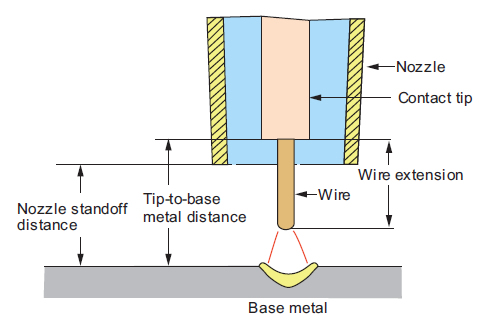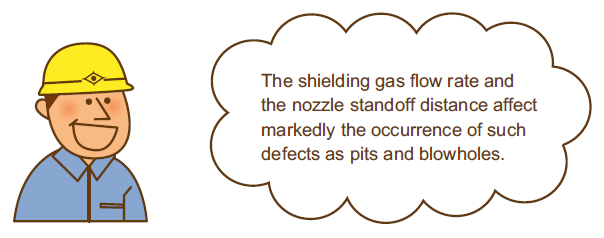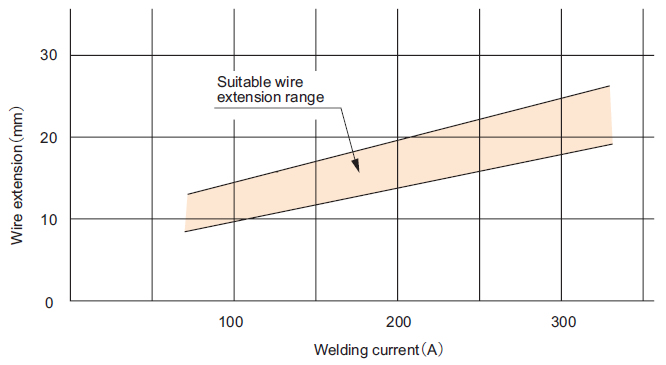- Home >
- Education Center >
- Fundamentals of CO2 Arc Welding >
- Fundamentals of MAG Welding (CO2 Arc Welding) >
Fundamentals of MAG Welding (CO2 Arc Welding)
7. Shielding gas flow rate and nozzle standoff distance

The shielding gas flow rate and the nozzle standoff distance affect markedly the occurrence of such defects as pits and blowholes.
Therefore, an appropriate gas flow rate and nozzle standoff distance must be determined considering the welding conditions. The relationships between the gas flow rate and blowhole, and between the nozzle standoff distance and blowhole are shown in the following tables. The last table shows the appropriate gas flow rates and nozzle standoff distances.
| Nozzle standoff distance (mm) |
Shielding gas flow rates (ℓ/min) |
Bead appearance | X−ray test results |
|---|---|---|---|
| 20 | 25 | ||
| 20 | |||
| 15 | |||
| 10 | |||
| 5 |
| Nozzle standoff distance (mm) |
Gas flow rates flow rates (ℓ/min) |
Bead appearance | X−ray test results |
|---|---|---|---|
| 10 | 20 | ||
| 20 | |||
| 30 | |||
| 40 | |||
| 50 |
| Wire diameter (mmφ) |
Welding current (A) |
Nozzle standoff distance (mm) |
Gas flow rate (ℓ/min) |
|---|---|---|---|
| 1.2 | 100 | 10~15 | 15~20 |
| 200 | 15~20 | 20~25 | |
| 300 | 20~25 | ||
| 1.6 | 300 | 20~25 | 20~25 |
| 350 | |||
| 400 |

8. Wire extension
The wire extension gives great influences on the appearance of the weld bead, penetration depth, arc stability and efficiency. If it is too short, larger amounts of spatter adhere onto the inside of the nozzle to hinder smooth shielding gas flow. The following table shows effects of the wire extension on various performances, and Fig. 5 shows the proper wire extension for the proper welding currents.
| Various performances |
Influences |
|---|---|
| Melting rate | With the constant welding current, the longer the wire extension, the larger the melting rate. |
| Arc stability | When the wire extension is excessive, the arc becomes unstable, and spatter increases. |
| Penetration | When the wire extension is excessive, penetration becomes shallow. |
| Porosity | When the wire extension is excessive, the nozzle standoff distance becomes long ; thus, the shielding effect becomes degraded, thereby causing higher tendency of porosity occurrence. |
| Others | When the wire extension is too short, the nozzle hides the sight of the welding groove and the weld pool. Spatter adheres much on the inside surface of the nozzle, thereby causing deteriorated gas shielding. In addition, the contact tip and the nozzle will severely be damaged. |

Fig. 5 Suitable wire extension vs. welding current
9. Forehand welding and backhand welding
In CO2 arc welding, the torch can be manipulated by the forehand welding technique or backhand welding technique. Each welding technique has different characteristics ; hence, you should choose the appropriate technique according to the application.
The forehand welding is adopted in many applications ; by contrast, the backhand welding is more suitable in groove welding with a high current.
・Forehand welding and backhand welding

Features of forehand welding :
- ①
- Easy to target the wire onto the welding line.
- ②
- Flat bead shape with low reinforcement.
- ③
- Consistent melt−through root pass bead.
- ④
- Comparatively large particles of spatter flown ahead.
- ⑤
- Shallow penetration due to the molten metal flowed ahead.
Features of backhand welding :
- ①
- Not easy to see the welding line hidden by the sight of nozzle.
- ②
- Narrow bead shape with high reinforcement.
- ③
- Difficult to obtain a consistent melt−through root pass.
- ④
- Low spatter generation.
- ⑤
- Deep penetration due to the molten pool formed backwards.
- ⑥
- Easy to control bead width and reinforcement due to ease of seeing the bead shape.
| Application | Forehand welding |
Backhand welding |
Reasons |
|---|---|---|---|
| Thin plate, Flat welding | ○ | × | Easy to see the groove. Shallow penetration with flat bead. |
| Medium/thick plate, Flat welding | ○ | ◎ | Deeper penetration, better usability, and fewer passes in backhand welding. |
| Horizontal fillet welding (1−pass weld) |
○ | × | Flat bead shape. |
| Horizontal fillet welding (Multi−pass weld) |
○ | ○ | Backhand welding is suitable for filling passes and forehand welding for cover pass. |






